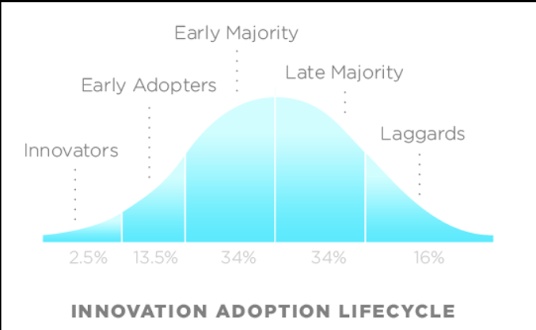The Technological Adoption Curve
Innovation Adoption Lifecycle
“The diffusion of innovations is the process by which a few members of a social system initially adopt an innovation, then over time more individuals adopt until all (or most) members adopt the new idea” (Valente 1996).
If I were to place myself along the spectrum of the Diffusions of Innovations Curve, I would place myself in the top 10% of adopters-putting me squarely in the “early adopters” category. I believe myself to fall within this category based on two factors:
My previous work experiences with technology and its implementation in varied environments and
My current hobbies and interests.
In my previous role, I served as a methods/procedures process engineer. I collected data to identify opportunities for process, communication, and training improvements. Additionally, I worked to improve measurable operating efficiencies and customer satisfaction scores by implementing improved troubleshooting processes and best practices. Many of these changes were guided by the principles of Lean and Six Sigma methodologies and measurement tools. We used technologies to help call center agents better serve customers. For instance, I created the first technical troubleshooting “decision tree/branched” user interface for the national knowledge management system, global customer relationship management system, and ATT.com. To my knowledge, using programmed decision flows based on symbolic logic to assist internal and external clients in troubleshooting cellular devices had never been done.
We used the technologies inherent in the existing systems in a new way. As Veletsianos (2016) points out, an emerging technology does not necessarily have to be new (p. 7). Rather, if a technology is used in a new way in a new environment, it can fit the definition of an emerging technology. At the time, I was leading the charge for improved technological tools for employees and customers alike.
In my personal life, I also embraced technology at an early stage. For instance, during the COVID-19 pandemic, I recognized that parents might need ways to entertain their children after they finished school. However, the parents were still working. I began designing and building high-end, custom PCs. The PC cases could include custom themes (one PC featured an anime doll that danced when powered on), lighting, and cooling solutions. Many of these cases made heavy use of high-density LED strips. Corsair’s iCUE software controlled these strips. Corsair sells lighting controllers to serve as interfaces between the iCUE software and the hardware that controls the lighting. Rather than spending the money on expensive name-brand Corsair controllers, I programmed Arduino Pro Micros to serve as the lighting controllers. The DIY lighting controllers were recognized by the Corsair software and worked seamlessly.
Sitting within the early adopter segment of the diffusion curve, I do feel that I have a keen understanding of the impacts of technologies on learning design. During my time at AT&T, I had access to one of the prelaunch, first-generation iPhones as part of my role as a senior instructional designer on the technical and new products design team. I was able, with the help of Apple developers, to introduce AT&T-specific training modules for the iPhone to familiarize employees with the new form factor and operating system. Buttressed with the new decision flows found within the knowledge management and customer relationship management software I built, employees had the training and the tools at their disposal to execute their job duties more efficiently and effectively.
My position on the diffusion curve might very well move closer to the innovator category as I learn about new and emergent technologies I have previously not encountered. By working with peers and mentors who are more experienced in various technologies, I hope to develop into an innovator in effectively implementing emerging technologies in learning environments.
I plan to build my knowledge by pursuing a course of self-study. Our community of practice group has already provided several resources that I can use to further my knowledge of generative AI prompting. My experience with AI text generators and image generators has been fairly limited. I hope “learning how to ask AI” the appropriate questions will help me in my professional development by learning how to harness these technologies better. I hope that as I work with these tools, I become more comfortable with using them rather than viewing them as technologies that may become replacements for me as a designer. I have already begun using AI-generated images as part of my personal life and am slowly becoming acquainted with how the engines work.
Understanding where I believe I fit on the diffusion curve helps me in a couple of ways. First, it helps me plan a roadmap to move closer to becoming an innovator, or at the very least, an early adopter. Secondly, and more importantly, it helps better understand where others fall on the diffusion scale and why. With this knowledge, I can better design individualized learning experiences for those who may be at the back end of the scale and are reluctant to adopt technologies. Understanding this, I can better empathize and slowly bring technology into their learning experiences at a more comfortable pace for them, rather than forcing them into technology's fast-paced evolution and implementation.
References:
Valente, T. W. (1996). Social network thresholds in the diffusion of innovations. Social networks, 18(1), 69-89.
Veletsianos, G. (2016). Emergence and Innovation in Digital Learning: Foundations and Applications. Edmonton, AB: Athabasca University Press.

